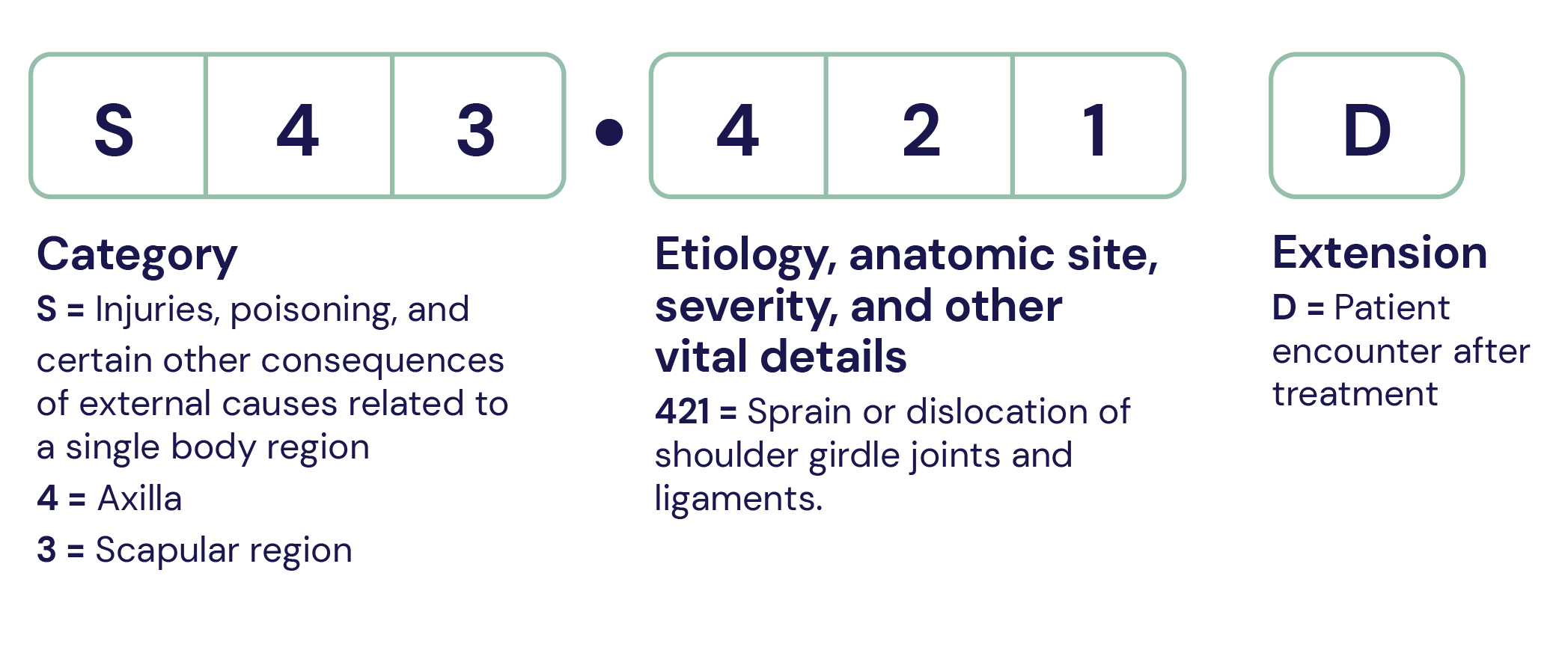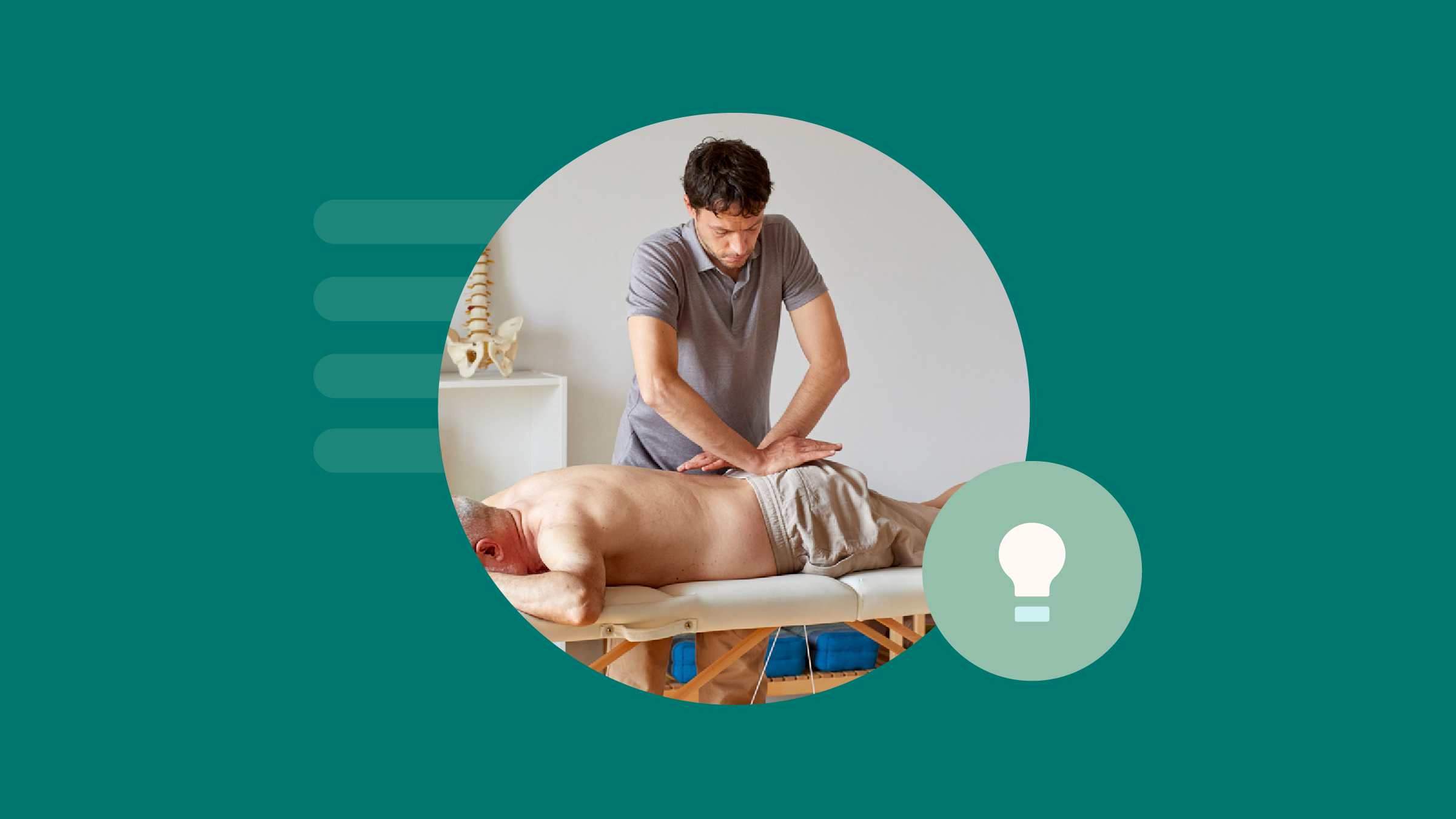A thorough, diagnostic resource for speech therapists, occupational therapists, and physical therapists.
The tenth edition of the International Classification of Diseases, or ICD-10, gives medical professionals a consistent naming standard for diagnosing conditions or diseases in patients. The World Health Organization (WHO) maintains and updates the ICD, which is used by epidemiologists, researchers, and providers in the U.S. and worldwide for both patient care and population health.
ICD-10 has been in use globally since 1992 and reached widespread medical use in the United States in late 2015 when the Centers for Medicare and Medicaid Services (CMS) required HIPAA-compliant providers to switch from ICD-9 to ICD-10. Internationally, ICD-10 will be replaced by ICD-11 on January 1, 2022, but the U.S. will likely delay implementation until 2023 or later.
In our guide, we’ll answer some of the most common questions around ICD-10, including how speech-language pathologists, occupational therapists, and physical therapists can harness ICD-10 for faster billing and reimbursement at your clinic. But first, let’s review some of the most common ICD-10 codes used in outpatient rehab therapy.
Common ICD-10 codes for physical therapy
For our complete top 25 list, download our resource for physical therapy ICD-10 codes.
| Code | Short Descriptor | Excludes Notes |
|---|---|---|
| M54.50 | Low back pain, unspecified | (M54.5-) Excludes 1: S39.012, M51.2-, M54.4- (M54.-) Excludes 1: F45.41 |
| M54.2 | Cervicalgia | Excludes 1: M50.- (M54.-) Excludes 1: F45.41 |
| M25.511 | Pain in right shoulder | (M25.5-) Excludes 2: M79.6-, M79.64-, M79.67- |
| M25.561 | Pain in right knee | (M25.5-) Excludes 2: M79.6-, M79.64-, M79.67- |
| M25.512 | Pain in left shoulder | (M25.5-) Excludes 2: M79.6-, M79.64-, M79.67- |
| M25.562 | Pain in left knee | (M25.5-) Excludes 2: M79.6-, M79.64-, M79.67- |
| M25.551 | Pain in right hip | (M25.5-) Excludes 2: M79.6-, M79.64-, M79.67- |
| M62.81 | Muscle weakness (generalized) | Excludes 1: M62.84 (M62.-) Excludes 1: G72.1, R25.2, G72.0, M79.1-, G25.82 (M62.8-) Excludes 2: M79.81 |
| M25.552 | Pain in left hip | (M25.5-) Excludes 2: M79.6-, M79.64-, M79.67- |
| R26.2 | Difficulty in walking, not elsewhere classified | Excludes 1: R29.6, R26.81 (R26.-) Excludes 1: R27.0, G11.-, A52.11, M62.3 |
Common ICD-10 codes for occupational therapy
For our complete top 25 list, download our resource for occupational therapy ICD-10 codes.
| Code | Short Descriptor | Excludes Notes |
|---|---|---|
| F84.0 | Autistic disorder | Excludes 1: F84.5 |
| F82. | Specific developmental disorder of motor function | Excludes 1: R26.-, R27.- Excludes 2: F70-F79 |
| R62.50 | Unspecified lack of expected normal physiological development in childhood | (R62.5-) Excludes 1: B20, E45 (R62.-) Excludes 1: E23.0, E30.0, Q99.1 |
| M62.81 | Muscle weakness (generalized) | Excludes 1: M62.84 (M62.-) Excludes 1: G72.1, R25.2, G72.0, M79.1-, G25.82 (M62.8-) Excludes 2: M79.81 |
| M25.511 | Pain in right shoulder | (M25.5-) Excludes 2: M79.6-, M79.64-, M79.67- |
| R27.8 | Other lack of coordination | (R27.-) Excludes 1: R26.0, G11.-, R42 |
| R62.0 | Delayed milestone in childhood | (R62.-) Excludes 1: E23.0, E30.0, Q99.1 |
| M25.531 | Pain in right wrist | (M25.5-) Excludes 2: M79.6-, M79.64-, M79.67- |
| M25.512 | Pain in left shoulder | (M25.5-) Excludes 2: M79.6-, M79.64-, M79.67- |
| M25.541 | Pain in joints of right hand | (M25.5-) Excludes 2: M79.6-, M79.64-, M79.67- |
Common ICD-10 codes for speech therapy
For our complete top 25 list, download our resource for speech-language pathology ICD-10 codes.
| Code | Short Descriptor | Excludes Notes |
|---|---|---|
| F80.2 | Mixed receptive-expressive language disorder | Excludes 1: H93.25, R47.-, F80.1 Excludes 2: G40.80-, F84.-, F94.0, F70-F79 |
| F80.0 | Phonological disorder | Excludes 1: R47,01, R48.2 Excludes 2: F80.4, F70-79, F80.1, F80.2 |
| F84.0 | Autistic disorder | Excludes 1: F84.5 |
| F80.1 | Expressive language disorder | Excludes 1: F80.2, R47.- Excludes 2: G40.80-, F94.0, F70-F79, F84.0- |
| F80.89 | Other developmental disorders of speech and language | |
| F80.9 | Developmental disorder of speech and language, unspecified | |
| R47.89 | Other speech disturbances | (R47.8-) Excludes 1: I69.-28 |
| R48.8 | Other symbolic dysfunctions | (R48.-) Excludes 1: F81.- |
| R63.30 | Feeding difficulties, unspecified | (R63.3-) Excludes 2: F50.-, F98.2-, P92.- (R63.-) Excludes 1: F50.2 |
| F80.81 | Childhood onset fluency disorder | Excludes 1: F98.5, R47.82, I69.-23 |
Frequently asked questions about ICD-10 in outpatient rehab therapy
ICD-10 is a complex topic to understand, but we’re here to help. Here are some answers to the most common ICD-10 questions from providers and billing professionals in outpatient rehab therapy.
What’s the difference between ICD-9 and ICD-10?
The ninth version of ICD was created in the late 1970s and was used widely in the U.S. medical industry until the CMS-mandated switch to ICD-10 happened in October 2015. While many of the codes remain the same from one version of ICD to the next, ICD-10 expanded the classification system from just under 18,000 to nearly 142,000 codes.
ICD-10 also allows for much more specific coding than ICD-9. ICD-10 implemented a seven-digit system to replace the previous five-digit system from ICD-9, allowing for more specification when submitting claims to payers. Providers use the additional digits to document the episode of care, the location of the condition on the body, and more.
Is ICD-11 in use yet?
The first stable version of ICD-11 came out on June 18, 2018, and received endorsement from the WHO the following May. It contains input from 300 global specialists and increases the size of the previous version nearly five-fold. Timing for implementation in the U.S. is currently under discussion, but the American Academy for Professional Coders (AAPC) estimates 2023 will be the earliest possible implementation date.
The World Health Organization reports that ICD-11 is designed to interface with health information platforms, such as electronic patient health records. It also implements a collaborative web-based editing feature subject to peer review and standardizes the way diseases and their symptoms are defined and reported for enhanced precision. Practitioners can access a free online version of the ICD-11 to review the changes before they take effect.
What’s the difference between ICD-10 and CPT codes?
ICD-10 provides a diagnosis code to describe the medical issues affecting the patient. CPT, which stands for Current Procedural Terminology, indicates treatment, surgery, or other procedures the patient received.
While these codes have different uses, both provide a common language for health care providers, insurance companies, medical billing companies, and other stakeholders. Both code sets also distinguishes between newborn, adult, pediatric, and maternity patients.
Let’s look at an example to illustrate the difference. Imagine that a speech therapist sees a patient with a speech articulation developmental disorder, which has an ICD-10 code of F80.0. After the appointment, the ST bills the patient’s health insurance for the completed procedures using the CPT code 92507 for “treatment of speech, language, voice, communication, and/or auditory processing disorder; individual.” The next patient appointment, the ST performs similar services using the same CPT code, but the patient has a different diagnosis: ICD-10 code F80.2, indicating “expressive language disorder.” Both the ICD-10 diagnosis code and the CPT procedure code(s) will be reported to insurance but represent different aspects of a patient’s case.
What’s the difference between ICD-10-CM and ICD-10-PCS?
The U.S. uses additional two-letter codes to represent the treatment setting as either outpatient or inpatient care: Clinical Modification (CM) or Procedure Coding System (PCS). ICD-10-CM, which includes approximately 68,000 codes, is for outpatient and clinical services. Approximately 87,000 codes in the ICD-10-PCS are used only when patients have inpatient hospital treatments in the U.S. Usually, OT, PT, and SLP practitioners will use ICD-10-CM codes for their patients.
Who has to use ICD-10 codes?
All health care providers who must comply with the Health Insurance Portability and Accountability Act (HIPAA) must use ICD-10 codes to report patient diagnoses.
Additionally, the CDC distinguishes between primary and secondary ICD-10 users. Primary users include all primary and specialty health care providers, such as doctors, nurses, therapists, and technicians, as well as those who work in medical billing and coding. Secondary users conduct public health research using ICD-10 code data.
According to WHO, the ICD-10 is used in 117 nations and has been translated into 43 languages. Key users in addition to health care providers include health information managers, patient advocacy organizations, insurance companies, and information technology workers in the medical sector.
Why are ICD-10 codes important for outpatient rehab therapy?
Therapists who conduct outpatient rehab, including physical, speech, and occupational therapists, use ICD-10 codes to document detailed descriptions of the diseases, health issues, and complications affecting their patients. These practitioners also report ICD-10 codes, as well as the appropriate CPT codes for treatment, for patient billing and reimbursement. Providing the appropriate codes for each patient case supports the medical necessity of the patient’s treatment plan, which facilitates prompt reimbursement.
How can ICD-10 changes impact reimbursements?
Providers and billers must report accurate ICD-10 diagnosis codes to payers for their patients’ treatment plans to be covered and for them to receive the appropriate reimbursement from payers. Inaccurate coding can lead to claim errors, denials, and a significant delay in payments.
However, ICD-10 can change to keep up with evolving medical knowledge, which has caught some rehab therapists and billers off guard. Initially, when ICD-10 was first mandated by CMS in 2015, a two-year moratorium was placed on ICD-10 changes for U.S. payer guidelines to help providers and clinic staff adjust to the new coding set. However, the moratoriums have since lapsed, meaning providers and clinic staff need to be aware of potential ICD-10 edits. We’ve listed some of the most recent changes at the bottom of our guide.
Having the right EMR and billing system can help your clinic immensely when it comes to ICD-10 compliance and updates. For example, Clinicient’s Insight Platform automatically updates when new ICD-10 codes are released, offers customizable payer rules so you can manually enter codes if necessary, and offers a searchable ICD-10 database with auto-fill for claims.
How do Excludes1 and Excludes2 Notes work?
CMS includes two types of excludes notes in their ICD-10-CM table. The first, Excludes1, is used to remind coders not to bill conditions together that cannot occur together. In other words, as CMS puts it: “NOT CODED HERE!”
For example, an Excludes1 notation with the acquired form of disease would prevent also coding for the congenital form of a disease. When documenting, providers should be as specific as possible when diagnosing the patient, as including additional symptoms can trigger an Excludes1 note, and result in a denial. As a general rule of thumb, aim to use the ICD-10 code that is the most appropriate for the condition, location on the body, and covers all the symptoms (without having to report those symptoms separately).
The other type, Excludes2, lets coders know that a patient can have two conditions simultaneously, but the condition below the excludes note is not part of the condition above the excludes note. Unlike the Excludes1 codes, you can include both the Excludes2 code and the condition above the excludes note together.
How are ICD-10 codes structured?
Each ICD-10 code consists of three to seven characters. The more characters, the more specific the code. Let’s look at a common physical therapy code, S43.421, used for the diagnosis of sprain of the right rotator cuff capsule.

The first three characters (S43) represent the category of a health issue. In this case, the first character (the only one that is always a letter) is S, which stands for “injuries, poisoning, and certain other consequences of external causes related to single body regions.” The next two digits (43) represent the injured area of the body—in this case, the axilla (4) and scapular (3) region.
The three digits after the period document the cause of the issue, the severity, the exact site, and other important details about the diagnosis. In our example, the characters 421 designate sprain or dislocation of shoulder girdle joints and ligaments.
What are encounter codes, or the seventh character in ICD-10?
Some codes have a seventh character—either A, D, or S. This letter indicates the type of patient encounter as follows:
- A: A patient encounter involving active treatment for the injury or external cause of symptoms. The code is not exclusive to the patient’s initial visit.
- D: A patient encounter after active treatment. Use this for a patient in recovery and healing for the injury in question.
- S: An encounter involving a complication, or sequela, of the initial injury. For example, you may see a patient for muscle pain resulting from a shoulder dislocation.
Generally, physical, occupational, and speech therapists will use the seventh character only for a code starting with S to designate an injury or external cause. Using the seventh character incorrectly can invalidate the entire code, impacting the billing and reimbursement process. Check the ICD-10 notes section for each code to ensure appropriate use.
Can providers report multiple ICD-10 codes?
Practitioners can use more than one ICD-10 code for a single patient encounter. When you access the ICD-10 code tables from CMS, check the notes section for the code to find out if you must or may use it in conjunction with other codes. Some codes may have an “Excludes1” note to let you know what codes cannot be reported together.
Many S codes can be paired with an external cause code, which adds information about the injury, such as where the event happened, what caused the injury, the activity involved, and even whether the patient is a member of the military. You can use multiple external cause codes, but they are only necessary when reporting the initial patient encounter.
Using the same code as before (S43.421), we would first report the S43.421A code for the patient’s shoulder sprain, with the A digit at the end to designate active treatment. We could also add the external status code of Y99.8 for amateur recreation, the activity code of Y93.61 for tackle football, and the place of occurrence code of Y92.017 for the yard of a single-family home. In other words, he hurt his shoulder while playing a friendly game of tackle football with friends and this is his first medical encounter for the injury.
Where can I find the latest news on ICD-10 codes changes or new codes for 2022?
Some of the best sources for new information about ICD-10 are:
- ICD-10 Codes: Diagnosis Coding Resources from the American Occupational Therapy Association (AOTA)
- ICD-10-CM Diagnosis Codes for Audiology and Speech-Language Pathology from the American Speech-Language-Hearing Association (ASHA)
- ICD-10 and ICD-10-CM from the American Physical Therapy Association (APTA)
- ICD-10 Resources and ICD-10-PCS Resources from the Centers for Medicare & Medicaid Services (CMS)
- CMS Medicare Coverage Database Search (MCD)
- Classification of Diseases from WHO
As of 2021, the newest codes to be added to ICD-10-CM are related to COVID-19, including:
- U07.1 (COVID-19)
- J12.82 (pneumonia due to coronavirus disease 2019)
- M35.81 (multisystem inflammatory syndrome (MIS))
- M35.89 (other specified systemic involvement of connective tissue)
- Z11.52 (Encounter for screening for COVID-19)
- Z20.822 (Contact with and (suspected) exposure to COVID-19)
- Z86.16 (Personal history of COVID-19)
Additionally, CMS occasionally removes codes if they’re deemed not descriptive enough for their coding standards. The most recent code table changes go into effect October 1, 2021, and include:
- Removal of M54.5 (low back pain)
- Suggested alternatives:
- M51.2- (lumbago due to intervertebral disc displacement)
- M54.4- (lumbago with sciatica)
- M54.50 (low back pain, unspecified)
- M54.51 (vertebrogenic low back pain)
- M54.59 (other low back pain)
- S39.012 (low back strain)
- Removal of R05 (cough)
- Removal of R63.3 (feeding difficulties)
- Suggested alternatives:
- R63.30 (feeding difficulties, unspecified)
- R63.31 (pediatric feeding disorder or dysfunction, acute)*
- R63.32 (pediatric feeding disorder or dysfunction, chronic)*
- R63.39 (other feeding difficulties, picky eater, feeding problem for elderly or infant)
- Suggested alternatives:
- Suggested alternatives:
*Codes also require, if applicable, associated conditions.




Comments